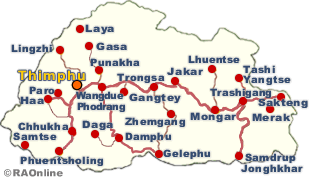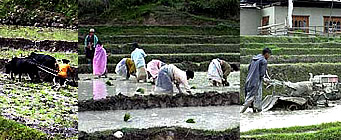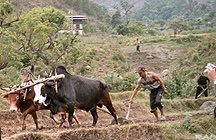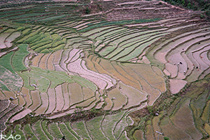| Bhutan's Economy: Agriculture |
 |
Bhutan Agriculture |
|
 |
Bhutan Agriculture |
|
|
 |
| Agriculture |
|
 |
Although
rice growing areas decreased by nine percent, rice
production in Bhutan increased by 58 percent between 1989 to 1997 according to an assessment of the rice research programme in Bhutan.
Titled
"An Economic Impact Assessment of the Rice Research Program in Bhutan",
the report states that despite the population growth, with the steady increase
in rice production in the country annual
rice imports had stabilised at an average of 33,000 (metric) tonnes in the recent years. |
|
The
increase in production, the report asserts, was primarily because of farmers'
easy access to improved varieties of rice. Improved rice technologies had
led to an increase in national rice output
by 5,000 to 10,000 tonnes a yea
According
to the report 15 improved rice varieties were made available to farmers
during the last two decades. Two of these varieties were developed at the
International Rice Research Institute in Philippines, seven in other countries
like India, Bangladesh, Japan, Korea, Nepal and Sri Lanka, and six varieties,
Bhutanese improved modern varieties of rice, were developed specifically
by the Bhutanese rice research scientists.
Bhutanese
modern varieties include Bajo Maap 1 and 2, Bajo Kaap 1 and 2, Yusi
Ray Maap and Yusi Ray Kaap. Most of them are blast resistant.
During
the period various improved management practices developed and adopted
include weed control, application of inorganic fertilisers, and land and
nursery preparation methods.
| Rice
availability improved |
 |
The
report states that 68 percent of the households
are now rice self sufficient while the average
national food shortage is estimated at 2.2 months.
Food
availability in rural areas has also improved, according to the report.
For example, household level studies in Wangduephodrang and Punakha valley
indicated that rice surplus increased from
13 percent in 1992 to 40 percent today. |
 |
| Bhutan's
rice areas |
 |
 |
Bhutan's
current rice area is estimated at more
than 26,000 hectares with a production
capacity of more than 60,000 tonnes.
Samtse had the highest rice growing area in Bhutan with 2,889 hectares followed
by Sarpangwith 2,839 and Punakha with 1,971 hectares. Production, however,
was highest in Punakha with 6,274 tonnes a year. |
| Bhutan's
three rice agroecologies |
 |
The
report classifies rice growing areas in Bhutan into three rice agroecologies:
 |
The
high altitude zone of 1,500 to 2,600 metres with warm temperate climate |
 |
The
medium altitude zones of valleys and foothills from 600 to 1,500 metres |
 |
The
low altitude zone of the southern rice belt ranging from 160 to 600 metres
above the sea level |
|
 |
| Bhutan's
rice production |
 |
 |
|
According
to RNR statistics, which the report uses, Bhutan produced 44,000 tonnes
of rice in 2000.
Per
capita milled rice consumption is one of the highest in the world at 167
to 262 kilogramme a year in western and southern Bhutan according to the report.
The
report identifies low soil fertility, prevalence of pests and diseases,
cold temperature, and high labour requirement as some of the major constraints
of rice production in Bhutan. Rice related research in Bhutan is spearheaded
by the renewable natural resources research centre in Bajo, Wangduephodrang. |
|
| Contributed
by KUENSEL, Bhutan's National Newspaper |
 |
top
| more information on Bhutan |
 |
|








